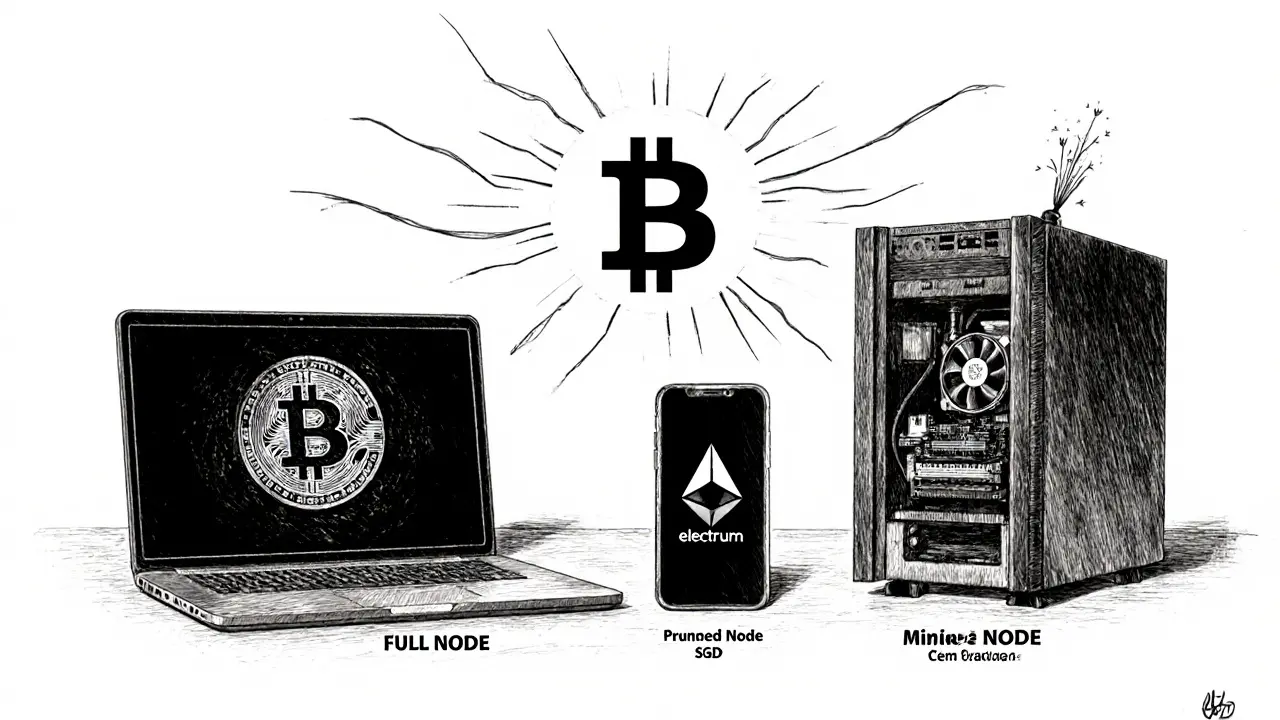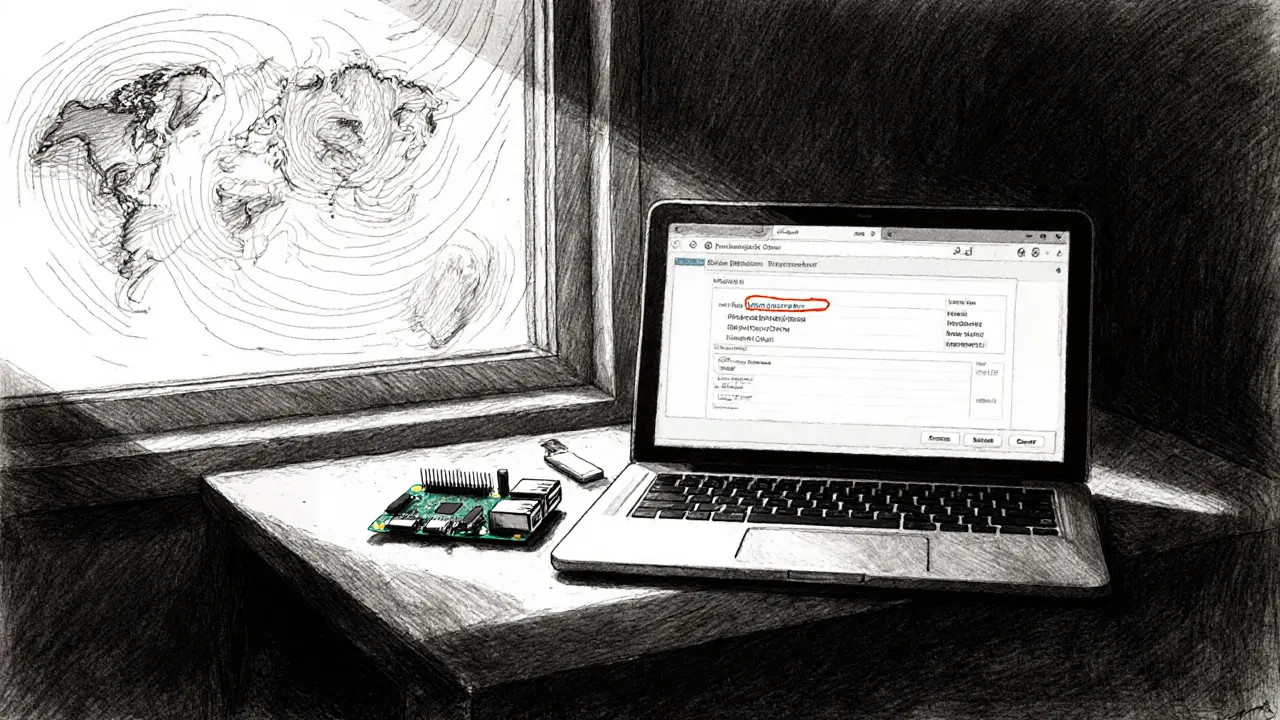Bitcoin Node Counter & Security Calculator
Current Node Count
24,266 reachable nodes (as of Oct 1, 2025)
Security Level
High based on current node count
Node Type Distribution
Security Impact Calculator
Network Security Analysis
With current node count of 24,266, Bitcoin maintains strong decentralization. Each node acts as an independent validator of the blockchain, ensuring no single point of failure. Adding more nodes increases redundancy and makes it harder for malicious actors to gain control.
Key Security Metrics
- Decentralization Score 92%
- Attack Resistance 94%
- Network Redundancy 88%
- Geographic Diversity 72%
- Privacy Protection 65%
- Community Participation 85%
When you hear "Bitcoin," most people picture a digital coin or price chart. What they rarely see is the sprawling network of computers that keep the system honest. As of October 2, 2025, there are roughly 24,000 Bitcoin nodes worldwide, and that number matters more than you might think.
Quick Takeaways
- About 24,266 reachable nodes are online, according to Bitnodes.io.
- Full nodes store the entire 500GB blockchain and validate every transaction.
- Geographically, ~65% of nodes hide their location, while the U.S. and Germany together hold just over 15% of identifiable nodes.
- More nodes mean higher security, lower risk of censorship, and better resistance to attacks.
- Running a pruned node can lower storage needs to under 100GB, making participation easier.
Current Bitcoin Node Count
Bitcoin is a decentralized cryptocurrency that relies on a peer‑to‑peer network of computers called nodes. As of the latest snapshot on October1,2025, Bitnodes.io lists exactly 24,266 reachable Bitcoin nodes. Coin.dance reports a similar figure-24,119 public nodes, of which 19,049 run the reference implementation, Bitcoin Core.
These numbers represent computers that have opened port8333 and are actively syncing with the network. The count fluctuates daily, but the trend over the past year shows steady growth of about 7-8% in IPv4 nodes and a healthier 14% rise in IPv6 participants.
Node Types and What They Do
Not every node does the same job. Understanding the differences helps you see why the total count matters.
| Node Type | Storage Needed | Primary Role | Typical Software |
|---|---|---|---|
| Full node stores the entire blockchain (≈500GB) and validates every transaction. | ≈500GB (growing ~1GB/few days) | Consensus enforcement, block/tx relay | Bitcoin Core, Bitcoin Knots |
| Pruned node keeps only recent blocks. | ≤100GB (configurable) | Same validation as full node, lower storage | Bitcoin Core (prune flag) |
| Lightweight (SPV) node downloads block headers only. | ≈2GB (headers) | Relies on full nodes for validation, fast start‑up | Electrum, Breadwallet |
| Miner node creates candidate blocks. | Full node data + mining hardware | Block production, fee collection | Bitcoin Core + mining software (CGMiner) |
Full nodes are the backbone of security. Even a pruned node still validates the consensus rules; it just discards old data. Light nodes are convenient for mobile wallets but trust full nodes for verification.
Geographic Distribution of Nodes
The network spans 102 countries, but the visible map tells a story of both diversity and hidden anonymity.
- ≈15,675 nodes (64.6%) appear as "n/a," meaning they hide their IP behind Tor, VPNs, or other privacy tools.
- United States: ~2,440 nodes (10.1%) - the largest identifiable chunk.
- Germany: ~1,319 nodes (5.4%).
- France, Canada, Finland each hold 1-3% of identifiable nodes.
This mix of hidden and open nodes creates redundancy. If a regional outage knocks out many U.S. servers, the hidden Tor nodes can still keep the network alive, and vice‑versa.

Why Node Count Matters for Security
Satoshi’s whitepaper states the system stays secure as long as honest nodes collectively control more CPU power than attackers. While modern attacks target bandwidth and connectivity, the principle is the same: the more honest participants, the harder it is to corrupt the ledger.
Each node holds a copy of the blockchain. To rewrite history, an attacker would need to convince a majority of these copies to accept a false chain-a practically impossible feat when there are >24,000 independent operators.
High node count also reduces reliance on centralized services like exchanges or block explorers. Users can verify balances directly with a node instead of trusting a third party, which mitigates phishing and censorship.
Practical Challenges for Node Operators
Running a full node isn’t just clicking a button. Here’s what operators face:
- Storage: 500GB and climbing. A pruned node can shrink that to ~50GB.
- Bandwidth: Continuous sync requires ~200GB/month of upload/download in a typical network.
- Uptime: Nodes need to stay online most of the time to stay useful for the network.
- Technical know‑how: Configuring firewalls, ports, and optionally choosing Tor for privacy.
Despite these hurdles, the community keeps adding new nodes. IPv6 adoption, rising Tor node counts, and the availability of lightweight hardware (e.g., RaspberryPi) help lower the entry barrier.
Future Outlook: Scaling the Network
The blockchain will keep growing-about 1GB every few days-so storage pressure will rise. However, two trends are likely to offset this:
- Improved storage costs: 1TB SSDs are now under $50, making a full node affordable for most hobbyists.
- Pruned and archival node options: Software updates let operators choose how much history to keep, preserving security without hoarding the entire chain.
Another boost comes from network‑level upgrades like BIP‑324 (encrypted P2P transport) and upcoming improvements to the P2P gossip protocol, which should reduce bandwidth per node while keeping propagation fast.
How You Can Contribute
If you’re curious about joining the network, here’s a simple roadmap:
- Pick hardware: a spare laptop, a low‑power PC, or a RaspberryPi 4 with a 500GB SSD.
- Install the latest Bitcoin Core client.
- Enable pruning if storage is a concern (add
-prune=550to the config). - Open port8333 on your router or run the node through Tor for extra privacy.
- Let the node sync-this can take a day or two on a fast connection.
Once synced, you’ll be part of the Bitcoin nodes that collectively protect the network. Even a single node adds a new copy of the ledger, making attacks marginally harder.
Frequently Asked Questions
How many Bitcoin nodes are there right now?
As of October1,2025, Bitnodes.io reports 24,266 reachable nodes, while Coin.dance lists 24,119 public nodes. The figure hovers around 24k.
What’s the difference between a full node and a pruned node?
A full node stores the entire blockchain (≈500GB) and can serve historic data to other peers. A pruned node discards old blocks after reaching a size limit, usually under 100GB, but still validates new transactions using the remaining data.
Do I need a high‑end computer to run a Bitcoin node?
Not necessarily. A modest PC or a RaspberryPi with a 500GB SSD can run a full node. Pruned mode reduces storage to ~50GB, making it even easier on hardware.
Why does node distribution matter for decentralization?
The more geographic and network‑level diversity you have, the harder it is for any single government or attacker to shut down or censor the network. Distributed nodes also protect against regional internet outages.
Can I run a Bitcoin node without exposing my IP address?
Yes. Many operators use Tor or VPNs, which is why roughly 65% of nodes appear as "n/a" in public scans. Using the -listen=0 flag also stops inbound connections while still validating the chain.

Wrapping Up
The takeaway is simple: every additional node makes Bitcoin safer, more private, and harder to control. With a steady rise in worldwide participation, the network remains one of the most resilient pieces of infrastructure today. Whether you run a full node on a spare laptop or simply appreciate the numbers, knowing the count and its impact helps you understand why Bitcoin still works after more than a decade.


Wow, the Bitcoin node stats are absolutely mind‑blowing! 🚀 Seeing over twenty‑four thousand nodes humming away makes my heart race. It's a testament to the community's relentless drive-and the network just feels alive like never before. 😃
Nothing beats the American spirit when we see this kind of decentralized power. The sheer number of nodes proves that freedom can thrive without central control, and that's exactly what our founding fathers would've wanted.
From a protocol‑level perspective, the node proliferation enhances the consensus robustness by increasing the active validator set, thereby reducing the probability of a 51% attack. Moreover, the expanded node topology improves partition tolerance across heterogeneous networks.
Great job on breaking down the numbers, folks! 🌟 Remember, every node you run is like planting a seed in the garden of security-more seeds, richer harvest. Keep the community spirit high, and the network will keep flourishing. 🌱😊
Honestly, these figures are just vanity stats; they don't guarantee true security. Most operators are clueless about proper configuration, so the network remains fragile.
Even if some nodes are misconfigured, the aggregate effect still pushes the decentralization needle forward, and that's a net positive.
What a vivid picture! The node landscape is a kaleidoscope of hardware-from sleek Raspberry Pi rigs to beefy workstations-each adding a splash of resilience. It's amazing how diverse the community can be.
Enough with the pretty metaphors-just run a node and stop whining about wallets. The network needs hands‑on miners, not day‑dreamers.
i think this article is super helpful lol! running a node might sound scary but it’s actually pretty simple once you get the basics down.
Totally agree! Just grab a spare laptop, flash a 500GB SSD, and follow the official guide-within a day you’ll be part of the security fabric.
In reviewing the data, one observes a notable trend, namely, the gradual increase in IPv6 node adoption; this development, in turn, broadens the network's reach, thereby fortifying its resilience, while simultaneously reducing reliance on legacy infrastructure.
It is, however, imperative to acknowledge that mere numerical growth does not equate to qualitative improvement; without stringent adherence to protocol specifications, the network's integrity may be compromised.
Let us consider the broader societal impact, which, as evidenced by the data, suggests a democratization of monetary sovereignty; this evolution encourages financial inclusion across underserved populations, fostering economic empowerment.
Sure, sure, lofty talk-while you write poetry, the network still needs hardware.
Reading through the node statistics feels like stepping onto a grand stage where every actor, from the humble home‑setup to the industrial‑grade server farm, plays a crucial role in the drama of decentralization. The sheer volume of 24,000‑plus nodes paints a picture of a living organism, pulsing with activity across continents. Each node, like a vigilant guard, monitors transactions and validates blocks, ensuring that no rogue actor can rewrite history. The distribution of full, pruned, lightweight, and miner nodes creates a layered defense, akin to a castle with multiple walls. Full nodes, bearing the weight of the entire blockchain, provide the ultimate proof of work, while pruned nodes strike a balance between storage efficiency and security. Lightweight nodes, though dependent on their peers, offer accessibility to everyday users, widening participation. Miner nodes, of course, drive the creation of new blocks, sustaining the incentive structure that fuels the network. Geographic diversity, with nodes hidden behind Tor and VPNs, adds an element of anonymity that thwarts targeted censorship. The presence of nodes in over a hundred countries underscores the global nature of this experiment in trust‑less finance. As storage costs decline, the barrier to entry continues to fall, inviting more enthusiasts to join the cause. Innovations such as encrypted P2P transport (BIP‑324) promise to further shield node communication from eavesdropping. The community’s willingness to adopt IPv6 demonstrates a forward‑looking mindset, ready to accommodate the next wave of growth. Moreover, the consistent upward trend in node count, even amidst market volatility, signals enduring confidence in the protocol’s resilience. Ultimately, each additional node contributes to a cumulative security margin, making the network harder to attack and more robust against failures. In sum, the numbers are not just a statistic-they are a testament to collective effort, ingenuity, and the belief that decentralization can thrive.
While the prose is impressive, one must remain vigilant against romanticizing numbers; empirical security requires rigorous testing beyond mere node counts, and complacency could be disastrous.
Life is a mirror, and the network reflects every node we place-each one a tiny affirmation of trust.
Exactly, keep it simple and keep it running! 👍💪
More nodes, more power.
I'm curious about the upcoming protocol upgrades and how they'll boost node performance-exciting times! 😊
Indeed, the upgrades promise faster propagation and lower bandwidth usage, which should encourage even more people to hop on board.
Everyone loves hype, but the real test is whether the network can survive a coordinated attack without crumbling.
From a formal standpoint, the resilience of the network depends on the stochastic distribution of honest nodes, the cryptographic difficulty adjustments, and the latency characteristics of peer connections; ensuring a diverse and well‑connected node topology mitigates the risk of adversarial dominance, while continuous monitoring of network health metrics provides early warning of potential vulnerabilities.